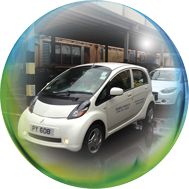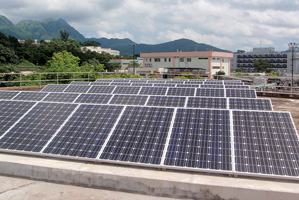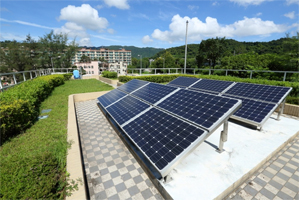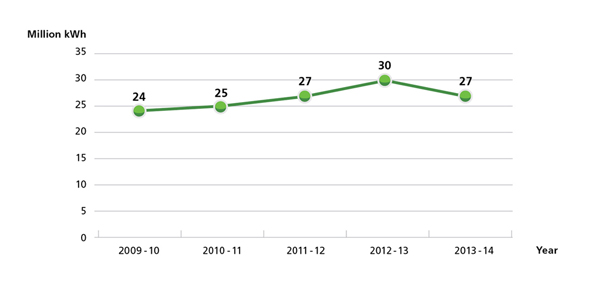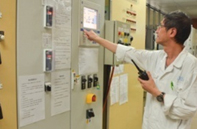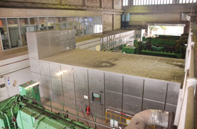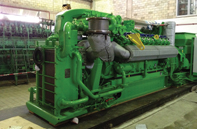Enhancing the environmental performance of our territorywide facilities is a crucial part of the environmental management strategy. Apart from this, we also engage our staff and suppliers to protect the environment in various ways, such as promoting green culture and green procurement.
Energy Management and Emission Control
Conducting Carbon Audit
Carbon audit is a method to identify, account and report the emission and removal of Greenhouse Gases (GHG), mainly carbon dioxide (CO2), from different processes within the boundary of an entity. Carbon audit enables identification of the major sources of emission and exploration of ways of reduction through reducing energy consumption, improving efficiency, using renewable energy etc.
We conducted carbon audits for Sha Tau Kok Sewage Treatment Works (STW), Shatin STW, Shek Wu Hui STW, Stanley STW, Stonecutters Island STW and Tai Po STW this year.
Looking forward, we are planning to extend the scope of carbon audits and carbon emission reduction measures to other STW and construction works. We will strive to reduce our carbon footprint and to operate in a more environmentally friendly manner while maintaining high quality drainage and sewage treatment services for the public.
Carbon Footprint in 2012
| Name of plant | Indirect emissions generated from the use of electricity | N2O emissions through nitrogen removal | Emissions generated from direct combustion of fuels | Others[1] | Total emission | CO2 equivalent emitted per m3 of sewage treated |
|---|---|---|---|---|---|---|
| (in tonnes of CO2 equivalent) | (in kg) | |||||
| Sha Tau Kok STW | 116 | 13 | 11 | 0 | 140 | 0.41 |
| Shatin STW | 17,323 | 782 | 2,362 | 67 | 20,533 | 0.25 |
| Shek Wu Hui STW | 6,781 | 377 | 2 | 31 | 7,191 | 0.24 |
| Stanley STW | 2,574 | 33 | 1 | 8 | 2,615 | 0.84 |
| Stonecutters Island STW | 36,498 | 0 | 8 | 329 | 36,835 | 0.07 |
| Tai Po STW | 8,538 | 368 | 17 | 92 | 9,016 | 0.26 |
| [1] | Sum of direct and indirect net GHG emissions resulted from planting of trees, refrigeration, methane release from sludge digester, electricity used for fresh water processing, and/ or methane generation at landfill due to disposal of paper waste. |
|---|---|
Use of Electric Vehicles
Electric vehicles (EVs) are powered by batteries without involving any combustion process. They have zero emission and help improve roadside air quality in Hong Kong. As at March 2014, DSD has engaged ten EVs and their average daily mileage was about 500 kilometres. We target to promote the wider use of EVs in future.
Implementing Various Energy Saving Measures
Energy and Emission Management Team was established in 2007 and headed by an Assistant Director with members from all branches at senior professional level. We have made steady progress in energy saving and emission reduction in our city-wide operation. DSD has saved more than 11.6 million kilowatt-hours of electricity over the past seven years, through implementing the following measures:
- optimisation of sewage treatment processes;
- use of combined heat and power (CHP) plants at various sewage treatment works;
- replacement of T8 fluorescent lamps and outdoor lights with T5 lamps, LED and wind solar hybrid lamps respectively at various plants; and
- use of high-efficiency pump motors in sewage treatment facilities.
In 2013-14, our performance in energy saving was promising. In particular, the co-settling and optimisation of aeration system at Shatin STW (0.88 million kilowatt-hours) and the optimisation of operation of centrifuges at Stonecutters Island STW (0.14 million kilowatt-hours) were among the largest contributors.
Use of Renewable Energy
Use of Photovoltaic Panels in Sewerage Facilities
We have installed large-scale photovoltaic (PV) systems supplying electricity to the equipment at some of our major facilities, including Yuen Long STW, Sai Kung STW, Shek Wu Hui STW, Stonecutter Islands STW, Sandy Bay PTW, etc. The total capacity and annual electricity output of the PV panels were about 128 kilowatts and 104,000 kilowatt-hours respectively. In the coming two years, we plan to install PV panels in nine other sewage treatment facilities at a total capacity of 891 kilowatt.
Turning Biogas to Energy
We have installed combined heat and power (CHP) generators and microturbine systems in our facilities for generation of renewable energy using biogas produced from the sewage treatment process. Adoption of CHP generator and micro-turbine fueled by biogas primarily are cleaner technologies that help reduce greenhouse gas emissions.
In 2013-14, we have completed installation of new CHP generators in Shatin and Tai Po STW (total capacity at 3,600 kilowatts), and microturbine in Yuen Long STW (capacity at 30 kilowatts). Together with the existing CHP generators of Tai Po STW (commissioned in 2010 with capacity at 625 kilowatts) and Shek Wu Hui STW (commissioned in 2011 with capacity at 635 kilowatts), the total amount of electricity generated from biogas in 2013-14 was about 27 million kilowatt-hours.








